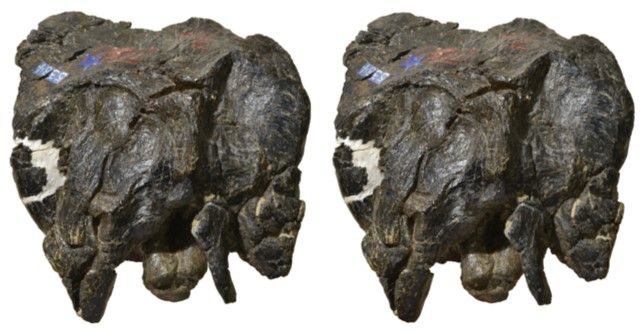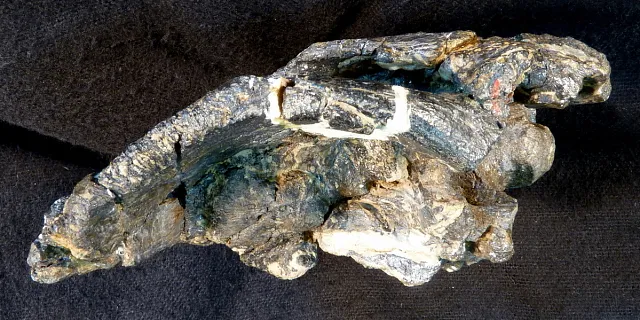NATIONAL MUSEUM OF NATURAL HISTORY
Scientists Give Old Dinosaur a New Name
A new study has reclassified a fossil discovered in 1883 as a dicraeosaurid — a family of long-necked dinosaurs rarely found in North America.
:focal(2020x1132:2021x1133)/https://tf-cmsv2-smithsonianmag-media.s3.amazonaws.com/blogging/featured/Nine_dark_rock_fragments_on_red_sand..jpg)
The Wild West of the 1800s was a place of hidden treasure. In the 1840s, people swarmed the land looking to make their fortune in gold. Then, in the late 1870s, paleontologists began searching for a different kind of valuable: dinosaur fossils.
Eventually, many of these fossils made their way to the Smithsonian’s National Museum of Natural History as part of the museum's paleobiology collection. Some of the specimens have been properly identified. Others are still enigmas.
Now, a paper in the Journal of Vertebrate Paleontology has reclassified one such fossil discovered in 1883 as a dicraeosaurid — a family of long-necked dinosaurs rarely found in North America. But there is something else that’s special about this fossilized head and vertebrae. The researchers have named the specimen Smitanosaurus agilis after the man who excavated it and the museum that has held it for over a century.
“One of the things that was important to us is the recognition of forgotten figures in paleontological history. In this case, it was a guy named J. August Smith who did a lot of the excavation and then we wanted to honor the institution that held it as well,” said Dr. John Whitlock, a paleontologist at Mount Aloysius College, research associate at Carnegie Museum of Natural History and first author on the paper.
Unearthed but unknown
Discovering a dinosaur fossil is one thing. Identifying it is something entirely different. This involves both taxonomy and classification, which are two interconnected but distinct processes.
“Taxonomy is asking ‘can I figure out what you are?’ and classification is ‘how are you all related?’,” said Dr. Matthew Carrano, curator of Dinosauria and research geologist at the museum. “This specimen was always defined as its own species because it was different from everything else we have. But we could not classify it or connect it with another known group. That’s now been solved.”
Whitlock and his colleague Dr. Jeffrey Wilson Mantilla, a paleontologist at the University of Michigan, curator at the university’s museum of natural history and co-author of the paper, first began studying the Smitanosaurus agilis specimen in the late 2000s. They were excited to study the fossil because the head and vertebrae hold valuable information.

“The back of the skull has a lot of information and a lot of distinct features as do the vertebrae. With something like the back of a skull, there are entry and exit points for nerves and blood vessels to connect to other bones. There’s three-dimensional information there that you can use to find unique attributes,” said Wilson Mantilla. He and Whitlock developed three-dimensional models that show these characteristics.
Scientists previously knew the animal was a sauropod, a taxonomic clade (or natural group) made up of giant dinosaurs known for their exceptionally long necks and small heads. When first discovered, the dinosaur was thought to be a new species of the genus Morosaurus —Morosaurus agilis. Later, most of the Morosaurus species were subsumed within another genus, Camarasaurus, but "Morosaurus agilis" was left in a taxonomic limbo, with an outdated genus name and no taxonomic home.
As Whitlock and Wilson Mantilla’s project progressed, the clues began to add up about where the fossil belonged in the dinosaur tree of life. Careful study of the small fragments associated with the specimen also fell into place, and the team was able to fit an articular facet onto the third vertebra. This fit was confirmed by a drawing of the specimen made by its excavator J. August Smith. This sketch confirmed the piece belonged and showed the original arrangement of the bones in the field.
It became clear that the specimen actually belonged to a family of sauropods known as the Dicraeosauridae. Although dicraeosaur species had been discovered in Africa and South America, until recently they hadn’t been found in North America. With its family finally determined, the enigmatic fossil also needed a new genus: Smitanosaurus.
“At its heart, this is how science in general is supposed to work. It's about allowing new information to change our perception. Here, that means reclassifying a thing and changing its name,” said Whitlock.
A tradition of collecting for future discovery

Paleontological research uses not just fossils but also field notes, maps and other material from when the fossils were collected.
“By collecting it all, including contextual information, you can track back to a real spot on the Earth in four dimensions — that is latitude, longitude, and altitude plus deep time, which is, in this case, the Late Jurassic. All that information is important and builds over time,” said Wilson Mantilla.
Paleobiology collections and archives at museums like the National Museum of Natural History serve as repositories for these materials. And all that material frequently leads to discoveries.
“Museums in general are known for being places where you can discover new species. By keeping these collections, we allow ourselves this possibility that in 100 or 200 years someone with more knowledge and ability can get more out of the specimen than we could,” said Carrano.
Related Stories:
A Smithsonian Dino-Celebrity Finally Tells All
An Elegy for Hatcher the Triceratops
Q&A: Smithsonian Dinosaur Experts Helps T. rex Strike a New Pose
Meet the Scientist Using Fossils to Predict Future Extinctions
Meet the Scientist Studying How Organisms Become Fossils

